National Trust.
The National Trust has several more or less working Cornish mining engines in its care. At Pool, Cornwall, at the heart of the Cornish Mining World Heritage Site, are two great beam engines, preserved in their towering engine houses. The pumping engine on the main site is one of the biggest beam engines in the world, with a 90” cylinder. On the other side of the A3047 is another site, with the great beam of the Michell’s Shaft winding engine poking out of the side of the engine house. Both engines can be seen in motion from time to time, driven by electric auxiliary motors. The main site, with a museum, audio-visual, and walk-through of various buildings, has a lot to see besides the engine.
When visiting, you’ll find that you can park outside the Michell engine house on an area of gravel, and later drive across the road to the far end of the Morrisons’ car park and the larger site.
See also ‘Levant Mine and Beam Engine’
Category: National Trust
Antony, Cornwall
National Trust.
The house, built in its present form between 1718-24, stands on a peninsula near the Tamar estuary. It is a charming and modest house, not particularly large, but the furnishings and the collection of portraits are of exceptional quality. The landscaped grounds include formal and woodland gardens.
I remember the house had some modern sculpture in the grounds. The house was also used as a set for the recent “Alice in Wonderland” movie.
Claydon House, Bucks.
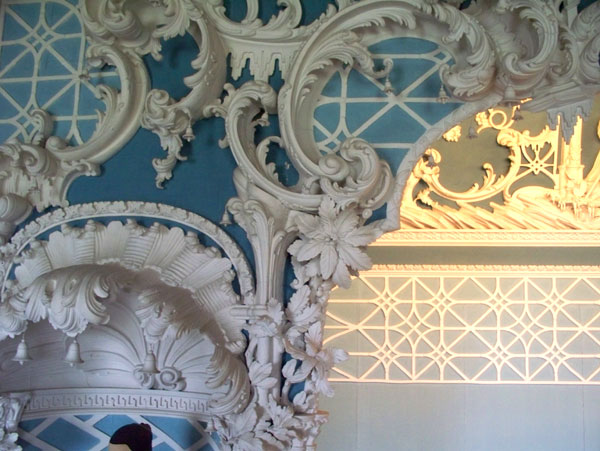
National Trust.
Ralph Verney inherited a Jacobean house in 1752, and reconstructed and extended it, before embarking on a still more grandiose scheme to create a great West front to rival that of his much richer neighbour, Earl Temple of Stowe. The surviving west wing contains some wonderful interiors, with carvings by the brilliant but rather difficult Luke Lightfoot, and plasterwork in the saloon and staircase by Joseph Rose. The ironwork and parquetry in the staircase are another marvel. There is also a Chinese room upstairs. Most of the unaffordable West front, including a grandiose rotunda and ballroom, was demolished by Ralph Verney’s neice and heir in the 1790’s, and there is no trace of it today.
There have been some changes since my last visit. NT visitor reception is around the corner to the left, facing the courtyard. The family have now moved out, so that two more rooms are open on the ground floor, and also another staircase to the upper floors. The model of the house has been relocated to one of the newly opened rooms. The South Lawn and an area of gardens with some formal flowerbeds are now open to visitors, accessible via the courtyard, and allowing close access to the rear of the house. A large walled garden is closed off and signed as Private.
The North hall contains Lightfoot’s wonderful bird carvings in high relief (actually white-painted wood), and the next room is equally impressive. To get upstairs one ascends an original staircase which goes up a long way (the ground floor rooms are very tall) giving access to a series of rooms including the music room with a gamelan orchestra in it, a grand bedroom, the Chinese room, and a museum room with various documents, and some architectural salvage. Florence Nightingale has connections with the house. One returns to the ground floor via a small modern staircase.
Outside, there is the inevitable retail courtyard around the old stable yard, also a church, parkland, and some gardens. Much of the outside is under separate management. The garden and South Lawn entrance is via the retail courtyard.
The Church can also be visited.
Altogether, there is enough to see to justify a half-day visit.
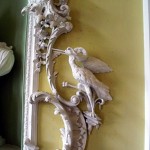
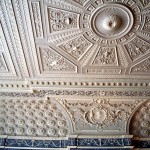
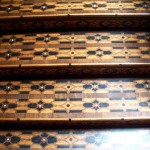
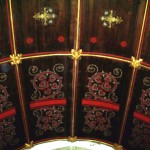
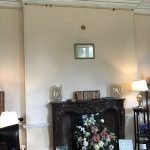
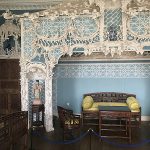
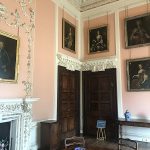
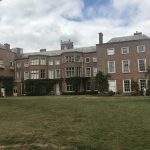
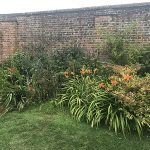
Anglesey Abbey, Cambs.
National Trust.
The house’s last wealthy owner bought the stone Jacobean manor house because it was conveniently placed for the stud he owned at Newmarket. He then transformed it over the next 40 years, filling it with his collections of fine and decorative art. 98 acres of unpromising fen were transformed into a garden. The house today is an Aladdin’s cave of priceless furniture, paintings and objets d’art, a collection that ranges over every style and period from all parts of the world. There is an exceptional collection of books in a library built in 1938, and paintings, including many of Windsor, in a square two-story gallery built on in 1955. In the grounds is the Lode Mill, an old water-mill now restored to working order.
There is plenty to look at in the house, including the sole visible fragment of the old Abbey, a vaulted room now used as the dining room, and the two-storey gallery extension which houses a number of impressive paintings and an elaborately painted piano.
Outside, exploring every section of the 114-acres of lawns and gardens should tire even the most energetic visitor. There are intimate flower gardens, courts with stone columns, and long tree-lined vistas, a canal, a woodland nature walk, and a lake. The house looks its most Jacobean from the south/garden side. On arrival, the visitor’s first mission is to find the house, which is several hundred yards from the car park, beyond a line of tree and shrub planting. At the Mill, you can admire the working machinery, and purchase flour and oatmeal ground there.
Townend Farmhouse, Cumbria
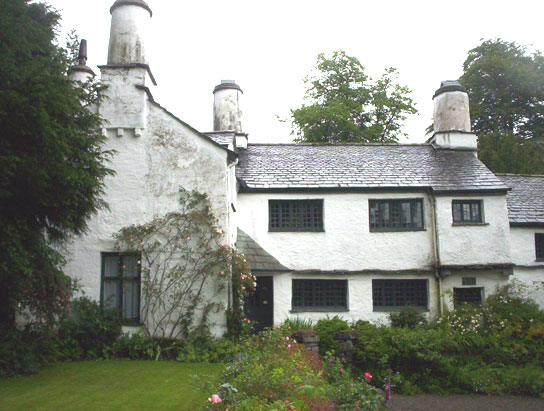
Townend is a rare and remarkably intact survival of the house of a family of yeoman farmers. The house largely dates from the seventeenth century, with limewashed walls, mullioned windows and a slate roof topped with six round chimneys. Just across the lane, dating from the same period as the house but built on a much grander scale, is the farm’s stone and slate galleried barn, with a ramp up to the granary floor and the date 1666 carved on one of the lintels.
The Browne family who lived here for over four centuries were sheep farmers, and seem to have gradually risen in society through careful management of their affairs. The contents were preserved by the last George Browne, an antiquarian and woodcarver, some of whose intricate carving remains in the house.
Much of the attraction of Townend lies in its contents, which reflect the Browne’s life and interests over several generations. There is a little library, with fiction, angling and farming periodicals, and a wealth of heavy oak furniture. Various old-fashioned rooms remain much as they were. There was a real fire burning in the kitchen on the day I visited.
The small garden has been re-created as it was in the Edwardian era.
Well worth a visit if you are in the area. It takes an hour or two to go round and see everything. Parking is some distance from the farmhouse.
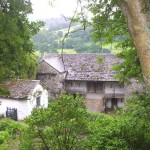
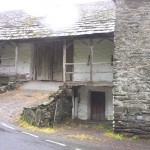
Lundy Island, Devon
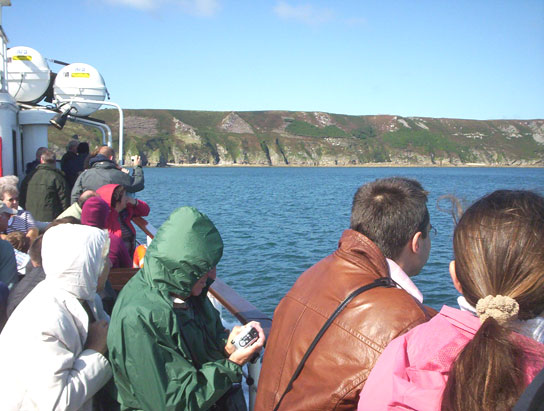
National Trust & Landmark Trust.
The car-free island encompasses a small village with an inn and Victorian church, and the 13th-century Marisco Castle. For nature-lovers there is a variety of flora and fauna. The waters around Lundy were designated the first Marine Conservation Area, and offer opportunities for diving and seal watching. Lundy is financed, administered and maintained by the Landmark Trust. There are cottages to rent, and also a campsite.
Access is normally by Lundy’s own ship, the MS Oldenburg. Sailings are from Bideford or Ilfracombe. It is possible to go for a day trip, which gives one about four hours ashore, enough time for an active person to visit the village and other locations on the half of the island nearer the landing pier. If you stay for a week, various away-from-it all experiences are possible, including doing as little as possible :-).
I went for a day trip, and got to the island on the second attempt, the first attempt being cancelled at short notice because of rough sea conditions. On the voyage, the sea was fairly calm, and the whole day was sunny. I visited the village, the pub, the church, the converted castle (now holiday lets), and various points of interest including the lighthouse in the middle of the island. There are some old ruins, the relics of granite mining on Lundy (a topic you can look up if you are interested.) The voyage itself is quite enjoyable on a fine day with good visibility, as various landmarks and ships slowly move in and out of view. As we approached, Lundy got bigger ahead of the ship quite suddenly.
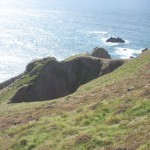
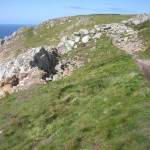
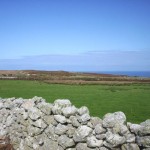
Coleton Fishacre, Devon
National Trust.
Not an ancient house, but built in the 1920’s for the D’Oyly Carte family, Coleton Fishacre is built of local Dartmoor shale and roofed with slate, and with its straggle of roofs it fits unobtrusively into the landscape. Inside, all is Arts & Crafts and Art Deco in style, and much use of limed oak and pine. At the west end of the house is a saloon 40 feet long, and furnished in yellow and green.
The interior is interesting, as all the rooms are furnished as though the 1930’s inhabitants had just left. Outside is a large 30-acre garden planted on a steeply sloping site, with many semi-tropical plants and flowers, and glimpses of the sea.
Access to the site is by a single-track road (“reversing required”) and roads in the area are narrow. There are other attractions in the area for walkers.
Overbeck’s, Devon
National Trust.
This is a museum of curiousities, set in an exotic semi-tropical garden. The last owner of the house, scientist and inventor Otto Overbeck, filled the house with his collections. There is a cabinet devoted to his inventions, which include an electrical “Rejuvenator”, designed to inject new life into the old and tired by passing electricity through the body. Also in the museum is a “Polyphon” a music box using large sheet steel disks, which plays music encoded as punched holes, also display photographs of various shipwrecks, and under the stairs a collection of dolls’ houses. The garden has some very steep slopes, and views over coastline and estuary.
This isn’t the easiest place to get to, as the roads leading to it are single-track, steep and twisty, and not suited for anything bigger than a minibus. There is a small car park near the house, for visitors, and if it’s full, finding alternative parking could be troublesome. If you are feeling really fit, it’s possible to park at East Soar and walk up (2 miles), or walk up from the ferry (1/2 mile). The NT handbook cautions drivers against paying too much attention to one’s sat-nav and advises following the brown signs from Marlborough towards Salcombe. As I recall, it was steep and narrow the direct way and steep and twisty by the brown sign route, neither an easy drive.
Finch Foundry, Devon
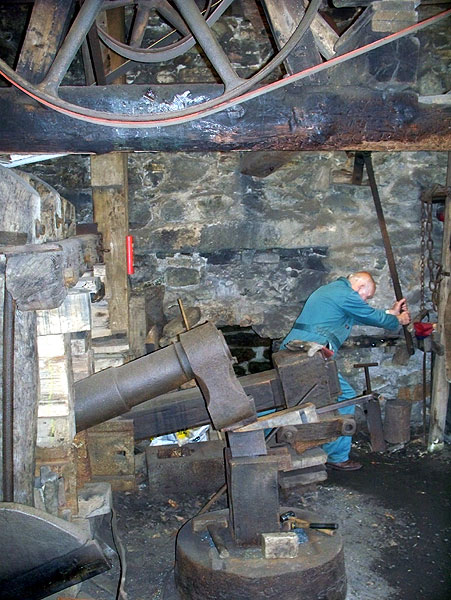
(National Trust)
This is the last remaining water-powered forge in England. The buildings and workshops have been preserved and the machinery is in working order. There are hourly demonstrations and tours, when you can see the waterwheels driving the tilt hammer and grindstone.
Upstairs is a small museum giving the history of the forge. In the grounds are a pleasant garden and a teashop. A Quaker cemetery adjoins the site. From the site one can take a circular riverside walk of about a mile and a half.
An interesting site, worth a visit.
Access to the car park is narrow, with a height restriction.
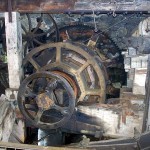
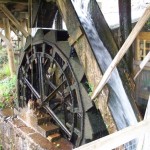
Compton Castle, Devon
National Trust.
A jumble of buildings and curtain walls enclose a courtyard. There are towers incorporated into the house and curtain wall, a great hall rising to the roof, a chapel, and an ancient kitchen wing. The house was built between the fourteenth and sixteenth centuries, and fortified in the reign of Henry VIII, no doubt in response to French raids on the Devon coast. The house was bought back by the Gilbert family in 1930 and restored as a family home after centuries of neglect.
The reconstructed great hall and a few other rooms are open to visitors, and there are rose, knot, and herb gardens adjoining. Don’t miss the rose garden (to left of front). This is a really unusual building and worth a visit if you are in South Devon. Opening dates are restricted to three days in the week. (Bradley (NT) nearby opens on the same dates.
Access to the house is via narrow lanes. Parking (on grass) at the house is limited and additional hard standing parking is available at the Castle Barton tearooms 100 yards away.
